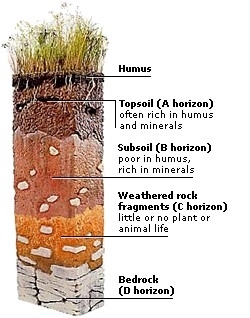Class VIII: Chapter 2 (Land, Soil, Water, Natural Vegetation & Wildlife) Question & Answers
Q1. Write the major factors affecting the formation of soil.
Ans: Factors affecting the formation of soil are: Relief, Parent Rock, Climate, Time and Organisms.
Q2. What are the different factors affecting land use pattern of an area?
Ans: Factors affecting the land use pattern of an area are:
(a) Physical Factors: Climate, Topography, Water availability, Soil, Minerals, etc.
(b) Human Factors: Population Density, Need & Desire of People, Development of Technology, etc.
(c) Economic Factors: Cost of living, Occupation, Financial conditions, etc.
Q3. Explain the different methods of soil conservation.
Ans: Some of the methods that can be adopted for soil conservation are: Mulching, Contour Ploughing, Terrace Cultivation, Strip Cropping, Shelter Belts, Rock Dam, Contour Barriers, Crop Rotation, etc.
Q4. What are the factors responsible for the shortage of freshwater?
Ans: Due to overpopulation, industrialization and urbanization, the consumption of water has increased manifold. Increased agricultural production to meet the growing needs of the population, modern lifestyle of the people and greater use of electricity in industries has resulted in water scarcity in many parts of the world. Above all the pollution of water bodies is due to irresponsible and reckless attitude of mankind. This has reduced the availability of fresh water for human consumption.
Q5. Define land degradation. How can we conserve land resources?
Ans: Decline in the productive capacity of land for some time or permanently is known as land degradation.
Some of the measures that can be used or practiced to conserve our land resource are:
(a) Adopting to the scientific techniques.
(b) Land Reclamation.
(c) Regulated use of chemical fertilizers, insecticides and pesticides.
(d) Afforestation.
(e) Check on Overgrazing.
(f) Control of Mining Activities.
(g) Proper irrigation facilities.
(h) Constructing retention walls in the mountain areas to stop landslides.
Q6. In India, what are the various steps taken to conserve forest and wildlife?
Ans: Following are few steps that have been taken to conserve forest and wildlife:
(a) National Forest Policy framed by the government should be implemented.
(b) National Parks, Wildlife Sanctuaries, Bioreserves, Botanical Gardens have been setup.
(c) Special Projects (E.g. Project Tiger, Project Elephant, etc.).
(d) Celebration of Van Mahotsav. Every National festival is followed by tree plantation ceremony.
(e) Controlling of deforestation and overgrazing. Large scale afforestation or planting of tress is undertaken.
(f) Social Awareness Programmes to be implemented.
(g) Wildlife Protection Act 1972.
Q7. Suggest different ways to conserve water.
Ans: Some of the important ways to conserve water are:
(a) Decrease of water pollution
(b) Proper irrigation method: Sprinklers and Drip irrigation can be used.
(c) Water Harvesting Method.
(d) Water conservation in the home:
(i) Check faults and pipes for leaks and insulate your water pipes.
(ii) Install water-saving shower heads and low-flow valves / taps.
(iii) Put plastic bottles or float booster in your overhead tanks.
(iv) Take shorter showers.
(v) Turn off the water after you wet your toothbrush.
(vi) Use your dishwasher and clothes washer for only full loads.
(vii) When washing dishes by hand, don't leave the water running for rinsing, etc.
Q8. Differentiate between Evergreen Forest and Deciduous Forests.
Ans:

Q9. Write a note on different types of soil.
Ans: Different types of soil are:
1. Alluvial Soil:
(a) It is the most fertile soil found in India.
(b) The alluvial soil is found mostly in the Northern Plains and Coastal Plains of India.
2. Black Soil:
(a) The black soil is also called the Black Cotton Soil formed from the weathering of the igneous rocks.
(b) The black soil is mostly found in the Deccan Trap, covering large areas of Maharashtra, Gujarat, western Madhya Pradesh, etc.
3. Red Soil:
(a) Red soil is derived from the weathering of the igneous and metamorphic rocks. The red colour is due to the high percentage of iron contents.
(b) Red soil is found in the southern and eastern parts of the peninsular plateau.
4. Laterite Soil:
(a) The laterite soil is found on the Western Ghats, Eastern Ghats, Vindhyas, etc.
(b) Due to intensive leaching, the laterite soil generally lacks fertility. The soil is suitable for producing plantation crops like tea, coffee, rubber, coconut, etc.
5. Mountain Soil:
(a) This type of soil is found in the Himalayan region, the Western, Eastern Ghats, etc.
(b) This soil is especially suitable for producing plantation crops, such as tea, coffee.
6. Desert Soil:
(a) The desert soil is found Rajasthan and the adjoining areas, receiving less than 50 cm of annual rainfall.
(b) The desert soil has sand (90 to 95 per cent) and clay (5 to 10 per cent).

Q10. What are soil horizons? With the help of a diagram explain the various soil horizons present in a soil profile.
Ans: Vertical section of the soil from the surface to the Bed rock is known as Soil profile. The soil profile is horizontally divided into four different horizons or layers known as Soil Horizons (as shown in the diagram). Top Soil, Sub Soil, Weathered Rock and Bed Rock or Parent Rock.
(a) Top Soil: It is the uppermost layer. Rich in humus and minerals. Consists of Sand, Silt & Clay. Leaching of soil is common in this layer.
(b) Sub Soil: It lies below the top soil and supports moisture. Consists of some amount of weathered rock, Silt & Clay and some nutrients. Minerals found here is more than Horizon A.
(c) Weathered Rock: Consists of large amount of weathered rock. These rocks are not affected by biological processes.
(d) Bed Rock: Last layer of the soil horizon. Consists of solid layer of unweathered Rock.
-----x-----X-----x-----

There are no published comments.
New comment